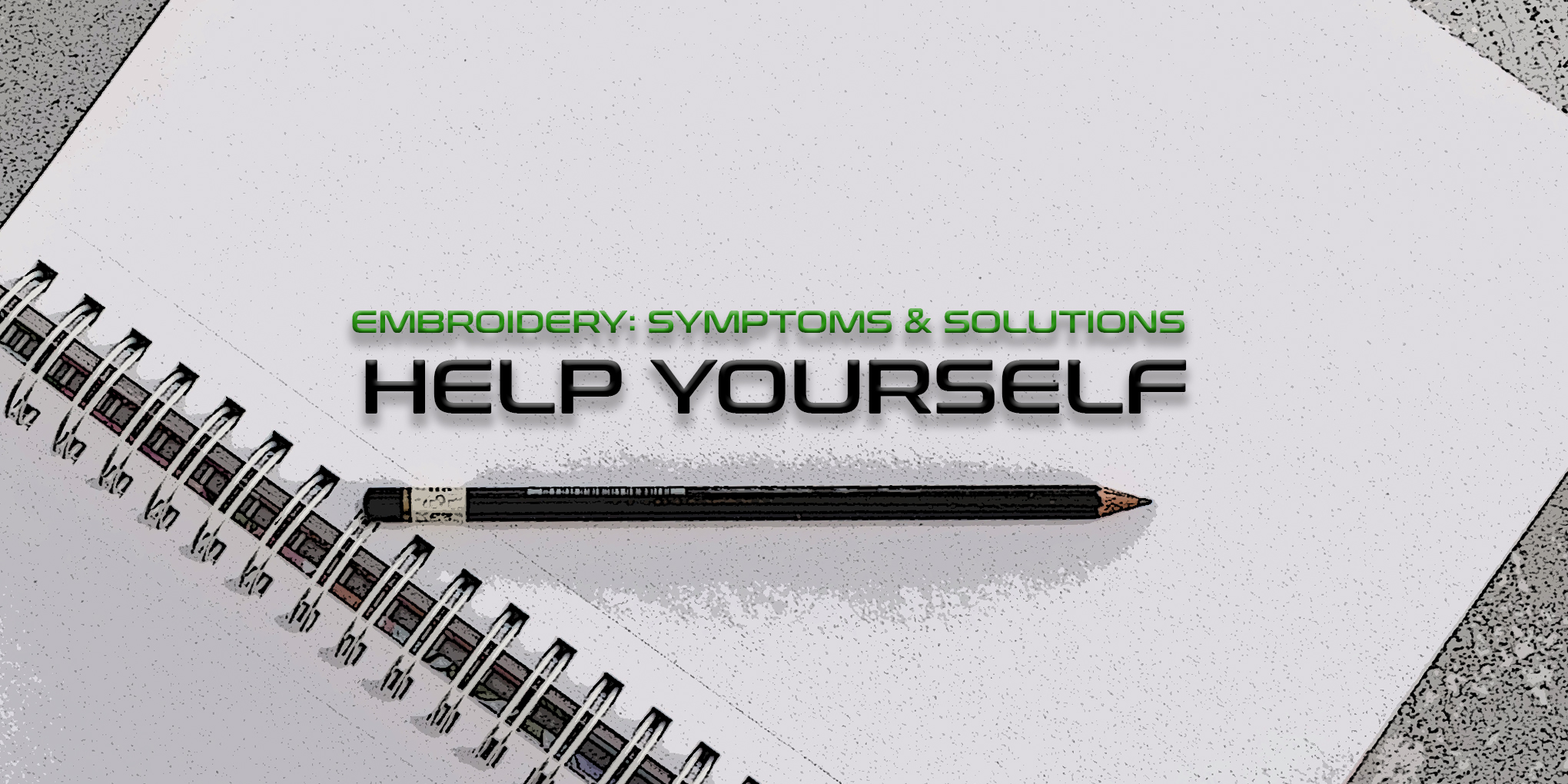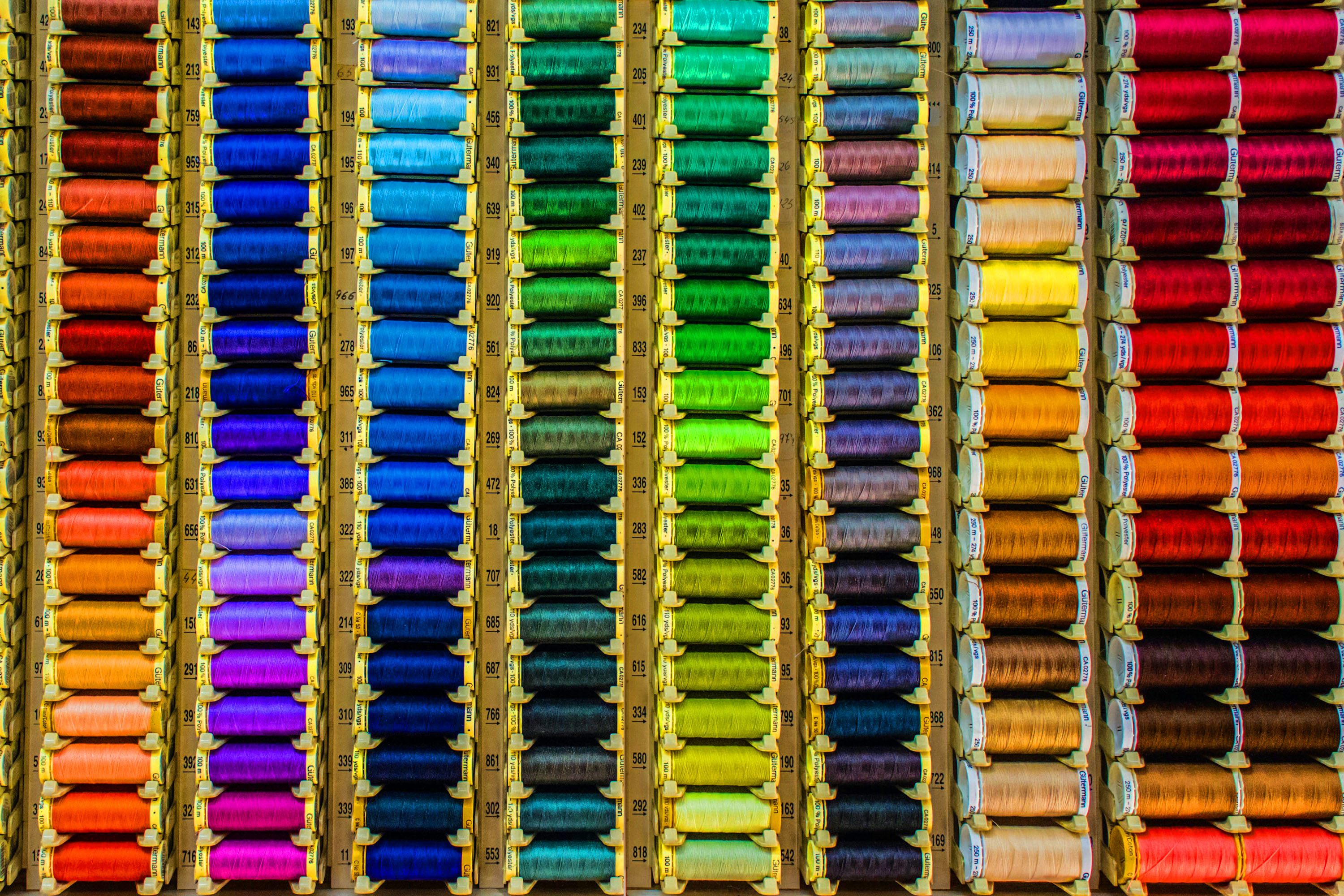01/09/2021

Embroidery: Symptoms and solutions
Save money by identifying and solving problems yourself
A very common problem in a machine embroidery or with an embroidery machine is a thread breakage. The following explains how to prevent or solve problems. The explanation includes everything on the subject: material, threads, mechanics and operating techniques.
The tensions
The tension of the threads must be constantly checked and adjusted on the embroidery machine.
If there is little or insufficient tension on the threads, thread breakage can occur.
If the tensions are wrong, inaccurate or even off, thread breakage could occur.
The tension should be in the 2/3 ratio. The upper thread should have 2/3 of the tension, the bobbin thread 1/3. To check, look at the back of the embroidery. One third of the bobbin thread should be visible there. In case of problems, also check the thread paths before each separate adjustment to make sure that the thread runs correctly in the devices of the embroidery machine. Embroider a tension test if necessary. Make a 2cm "I" or a 5mm wide line. If the thread is not threaded correctly, the embroidery machine will not embroider and will only display an error code. If in doubt, it is recommended to unthread the upper thread and bobbin thread completely once and rethread correctly.
Embroidery threads
Embroidery threads or sewing threads can be a big determining factor for thread breakages and problems. Threads, for high quality embroidery, have a life span. If they are exposed to the elements, e.g. air conditioning, wind, heat, cold, humidity, oily hands etc., it can have a negative effect on the embroidery result. A good test to check the quality of the thread is to break the thread manually. Break the thread by hand, possibly comparing a new embroidery thread of the same brand for its difference.
You can also have the embroidery shop embroider new high quality thread with the same logo that had the problems, if the problems remain it is a software or other machine problem. If the thread breaks disappear, they have found the fault.
Sometimes it can also help to remove the first 2-3 layers of thread from the embroidery thread spool to reveal the thread that was previously protected from the elements. Usually, however, much more thread is unstable and causes embroidery faults. It is recommended to buy the embroidery threads in quantities that can be used up quickly. Good storage in the embroidery room is also a good trick to protect the threads. Leave the embroidery threads in a cardboard box and put them in a sealable plastic box.
Needles / Embroidery needles
Embroidery needles are usually not a cause for major problems. The embroidery needles have a very high load limit and long durability. Nevertheless, they can become dull or get small scratches and bumps. Mostly due to embroidering hard, heavy textiles. You can test the needle by pulling the tip diagonally across a fingernail. If you feel a resistance or the needle leaves scratch marks, it is no longer usable as an embroidery needle on the embroidery machine. Since even very good embroidery needles are very inexpensive, it is often better for embroidery to replace all needles once in case of doubt. In general, the needles on an embroidery machine should be completely replaced once every 12 months.
Material
Certain materials require special digitising. A good digitizer should always know what material the design will be on before creating the embroidery programme.
If the material is not properly hooped this can also be a cause of problems. The design or the embroidered pattern can also cause big problems if it is not programmed properly. Embroidery programme creation is a fine art in itself. It is very important that it is done cleanly and perfectly. If an embroidery programme is programmed incorrectly or not well, it can lead to holes in the fabric, thread breaks or other unpleasant problems. If errors occur during embroidery that did not occur with previous logos, this is usually due to a bad embroidery programme.
Needle hernia
Several factors can lead to an umbilical fracture.
- The needle may be overloaded due to a long life, therefore it becomes unstable and breaks.
- Proper placement of the embroidery needle in the machine is very important for it to work properly. If the needle is too loose in the embroidery machine or if it is placed in the wrong position at an angle, it can cause the needle to break.
- Textiles that are very hard and stiff or have large bumps are very dangerous for an umbilical breakage. If a textile or garment is too thick, the hoop may move during the embroidery process while the needle is still inserted in the textile. This results in an immediate breakage of the needle. This is easily recognisable by the needle either being bent or broken into several pieces. However, the frame movement can usually be adjusted in the embroidery machine software. This means that this error can be repaired or minimised during embroidery.
Upper thread loops when embroidering
If small loops or loops form in the embroidery image when embroidering, this can have several reasons.
- The thread tension may be too loose and should be turned a little tighter, stronger, but adjust the machine carefully and work step by step here. On the embroidery machine, screw individual thread tensioners slowly and in half turns to the desired tension. It is best to do this directly under the embroidery process to see the result immediately. Take your time when adjusting the upper thread tension. Turning the thread tensioner too "senselessly" without knowing what exactly you are adjusting can lead to an even worse embroidery mistake.
- Some machines have software installed that can correct looping by adjusting the hoop movement or needle penetration depth. However, it is best to discuss these functions with the embroidery machine manufacturer before adjusting them, and perhaps seek the opinion of an embroidery machine technician.
Generally, it is the needle depth or the hoop movement that needs to be adjusted.
Thread splitting
If the thread does not break immediately, splitting occurs, i.e. the splitting of the thread tissue. This looks like a bird's nest. Since embroidery thread always consists of several smaller threads, it can happen that due to a mistake one of the many threads breaks and the thread then slowly unravels, so to speak, during embroidery. A main cause for this is a blunted, broken needle or an error in the thread path on the embroidery machine. Dirt can also play a decisive role in this. Always keep your embroidery machine as clean as possible. Dust or other dirt in the thread path, e.g. in the thread brakes or in the top: In the thread brakes or in the upper thread monitor can lead to unpleasant faults and problems when embroidering.
Vibrations and noises during embroidery
If an embroidery machine vibrates excessively, it could mean that the machine is standing on an unsuitable surface. Padding with e.g.: Rubber pads can minimise the vibrations. In general, the embroidery machine should be placed on its designated support or on a very solid and stable table.
Attention: If there are noises like a loud ticking or grinding especially noises that sound like metal on metal it means that there is a lack of oil or grease. This problem should be corrected immediately, otherwise it can lead to irreparable damage to the stick machine.
Maintenance of the embroidery machine
- The embroidery machine should be constantly and continuously maintained and serviced by the user. Read the user manual and check the places and positions where the machine needs oiling. There are places where you need to oil and grease the machine daily, some places are more maintenance free and only require embroidery machine oil or grease every few days or weeks.
- Some machines have software installed that can correct looping by adjusting the hoop movement or needle penetration depth. However, it is best to discuss these functions with the embroidery machine manufacturer before adjusting them, and perhaps seek the opinion of an embroidery machine technician.
Generally speaking, it is the needle depth or the frame movement that needs to be adjusted.
- Needle changer: Along the needle bar, at the embroidery head of the embroidery machine is a position where oil needs to be added regularly. Lubrication at this point should be done 1-2 times a week.
- Vertical needle bar and spring: Here a little oiling should be done once a month. Attention: After oiling a few small drops of a good embroidery machine oil, you should first run a few test embroideries so that the oil can distribute itself in the machine and no oil residues or oil drops get on the fabric afterwards.
- Bobbin thread: Oil there 1-2 times a day. When the bobbin becomes warm, it is time to oil it. The bobbin should always be oiled.
Operating errors
Embroidery machines are usually very easy to operate. However, it is absolutely necessary to have received the necessary training for embroidery operation. Do not allow employees to operate the embroidery machine without prior training.
A short training by a professional in the embroidery business can save you a lot of time and money. A mistake such as: Embroidering into the hoop because of a too small hoop or the wrong setting of the centre can lead to high costs and especially to a long standstill of the embroidery machine.
Embroidery machine mechanics / technicians
If you are stuck on your embroidery machine, it is very helpful to contact an embroidery machine technician in advance by phone. In many cases, with their help and instructions, you can repair some embroidery machine faults yourself.
If you get stuck yourself, the embroidery technician will have to solve the problem on the spot. It is important that you describe the problem as well and in as much detail as possible.



